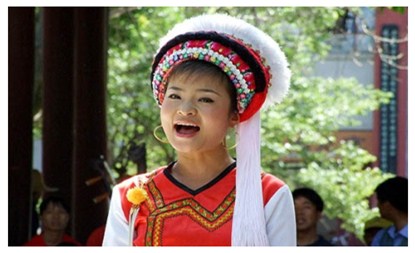Skype: neodalle-travel
Tel: +86 135 7447 2266
E-mail: sales@zhangjiajieholiday.com

 people have established a close relationship with the Han, the Miao, and the Tujia, during their long-term coexistence. To this day, they have maintained economic and cultural exchanges, and influenced one another.
people have established a close relationship with the Han, the Miao, and the Tujia, during their long-term coexistence. To this day, they have maintained economic and cultural exchanges, and influenced one another.Dressing & Clothing
Bai people hold the white colour in high esteem, and like to wear white clothes, the men often wearing white coats, with black vests .Women like to wear white or blue jackets, with black or blue vests. Unmarried women like to have a pigtail, or wear beautiful headdresses. Married women coil their hair, and wrap it with black or embroidered cloth.
Festivals of Bai Minority
The major festivals of the Bai are the Raosanlin, the Torch Festival, the Patron God Festival, and the March Fair. The Torch Festival and the March Fair are the Bai's traditional festivals. The March Fair falls between March 15th and 20th of the lunar calendar. It is a fair, as well as an occasion for sporting contests and theatrical performances. People gather there to enjoy dances, horse racing, and other games. The Torch Festival is held on June 25. Torches are lit everywhere, to usher in a bumper harvest, and to bless the people with good health and fortune. Streamers bearing auspicious words are hung in doorways and at village entrances, alongside the flaming torches. Villagers, holding torches aloft, and walk around in the fields, to drive insects away.
Customs of Bai
The Bai are very hospitable, and treat their guests to baked tea whenever they come to visit. Colloquially called "Three Courses of Tea", the tea is bitter in the first course, sweet in the second and most memorable after the third. In some places, they add honey and Chinese spice to the baked tea, which leaves a lingering and refreshing mellow after-taste.
The Bai people mainly believe in "Benzhu"(the village god). In each village and region, the Benzhu has a different meaning attached to it. Some are referred to as the God of Nature, others as national heroes, famous officers, and loyal women. A small group of them also believe in ghosts and Buddhism.
As for their marriage custom, matches between young men and young women of the same surname or clan are not permitted. Before the founding of the People's Republic of China in 1949, marriages were arranged by the parents, but now young people enjoy the freedom to choose their own marriage partners.
Folk Culture and Art
In successive dynasties, the Bai were named Baizi, Baihuo, and Baini, meaning white people. In 1956, they were formally named the Bai ethnic minority, because of their worship of the white color.
Over the centuries, the Bai have created the science and culture of their own, and agriculture was dominant. They cultivate rice, wheat, broom corn, millet, and several other crops. To their credit are inventions and advances in meteorology, astronomy, the calendar, architecture, medical science, literature, music, dancing, carving, and painting. The valuable experiences of the Bai people are recorded and summarized in detail.
The language of Bai belongs to the Bai branch of the Zang-Mian Austronesian of the Chinese-Tibetan Phylum. They have also invented their own written characters, based on Chinese characters. Their language contains a large number of Chinese words, due to the Bais' long contact with the Han. Today, among the Bai, the Chinese language is most widely used.
The Bai people are good singers and dancers. The "Lion Dance" was appreciated in the central plains during the Tang Dynasty (618-907). Bai opera, known as "Chuichui", is an art form that combines both folk music and dancing, and has also absorbed some of the characteristics of Han operas.
 Ask Questions ?
Ask Questions ?